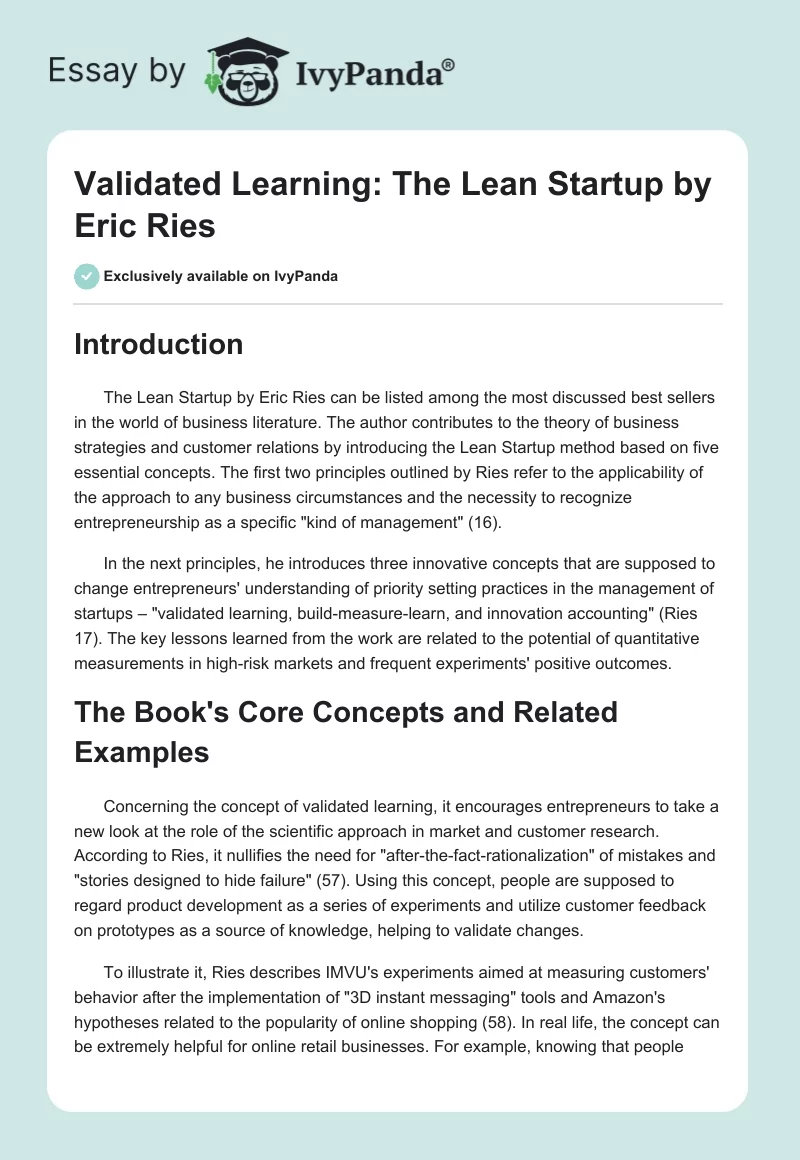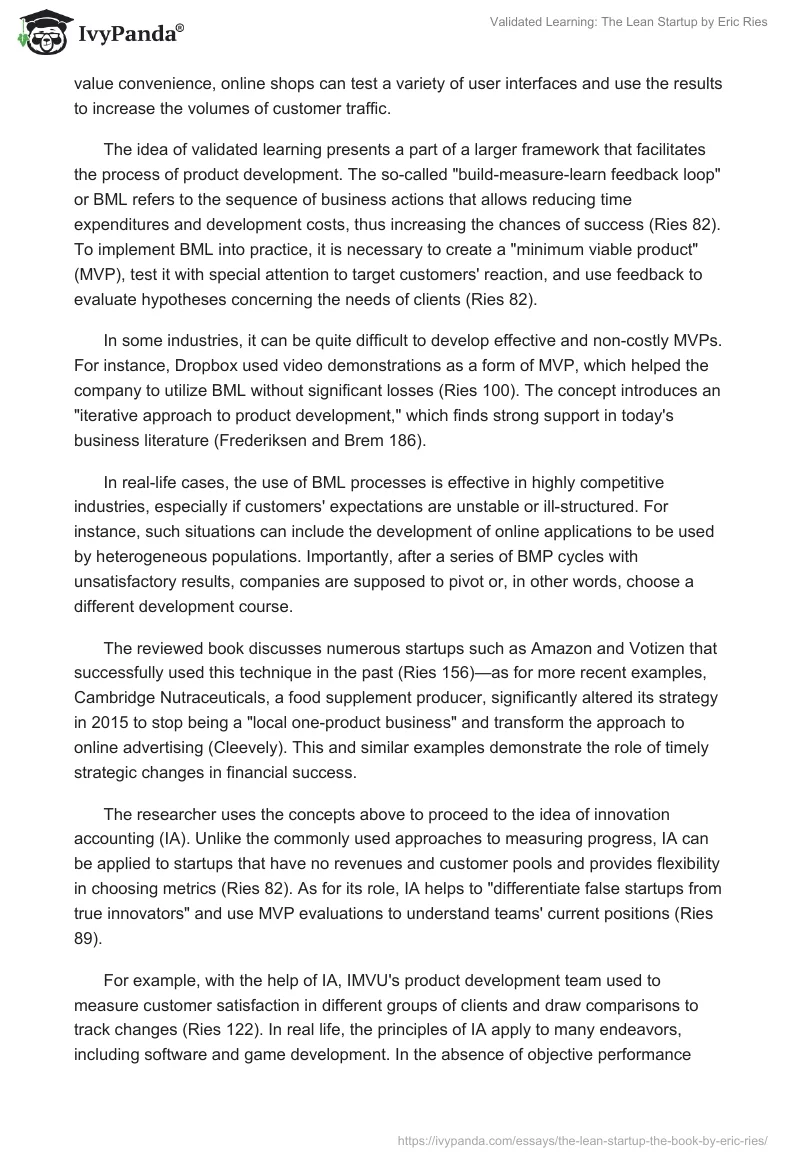Introduction
The Lean Startup by Eric Ries can be listed among the most discussed best sellers in the world of business literature. The author contributes to the theory of business strategies and customer relations by introducing the Lean Startup method based on five essential concepts. The first two principles outlined by Ries refer to the applicability of the approach to any business circumstances and the necessity to recognize entrepreneurship as a specific “kind of management” (16).
In the next principles, he introduces three innovative concepts that are supposed to change entrepreneurs’ understanding of priority setting practices in the management of startups – “validated learning, build-measure-learn, and innovation accounting” (Ries 17). The key lessons learned from the work are related to the potential of quantitative measurements in high-risk markets and frequent experiments’ positive outcomes.
The Book’s Core Concepts and Related Examples
Concerning the concept of validated learning, it encourages entrepreneurs to take a new look at the role of the scientific approach in market and customer research. According to Ries, it nullifies the need for “after-the-fact-rationalization” of mistakes and “stories designed to hide failure” (57). Using this concept, people are supposed to regard product development as a series of experiments and utilize customer feedback on prototypes as a source of knowledge, helping to validate changes.
To illustrate it, Ries describes IMVU’s experiments aimed at measuring customers’ behavior after the implementation of “3D instant messaging” tools and Amazon’s hypotheses related to the popularity of online shopping (58). In real life, the concept can be extremely helpful for online retail businesses. For example, knowing that people value convenience, online shops can test a variety of user interfaces and use the results to increase the volumes of customer traffic.
The idea of validated learning presents a part of a larger framework that facilitates the process of product development. The so-called “build-measure-learn feedback loop” or BML refers to the sequence of business actions that allows reducing time expenditures and development costs, thus increasing the chances of success (Ries 82). To implement BML into practice, it is necessary to create a “minimum viable product” (MVP), test it with special attention to target customers’ reaction, and use feedback to evaluate hypotheses concerning the needs of clients (Ries 82).
In some industries, it can be quite difficult to develop effective and non-costly MVPs. For instance, Dropbox used video demonstrations as a form of MVP, which helped the company to utilize BML without significant losses (Ries 100). The concept introduces an “iterative approach to product development,” which finds strong support in today’s business literature (Frederiksen and Brem 186).
In real-life cases, the use of BML processes is effective in highly competitive industries, especially if customers’ expectations are unstable or ill-structured. For instance, such situations can include the development of online applications to be used by heterogeneous populations. Importantly, after a series of BMP cycles with unsatisfactory results, companies are supposed to pivot or, in other words, choose a different development course.
The reviewed book discusses numerous startups such as Amazon and Votizen that successfully used this technique in the past (Ries 156)—as for more recent examples, Cambridge Nutraceuticals, a food supplement producer, significantly altered its strategy in 2015 to stop being a “local one-product business” and transform the approach to online advertising (Cleevely). This and similar examples demonstrate the role of timely strategic changes in financial success.
The researcher uses the concepts above to proceed to the idea of innovation accounting (IA). Unlike the commonly used approaches to measuring progress, IA can be applied to startups that have no revenues and customer pools and provides flexibility in choosing metrics (Ries 82). As for its role, IA helps to “differentiate false startups from true innovators” and use MVP evaluations to understand teams’ current positions (Ries 89).
For example, with the help of IA, IMVU’s product development team used to measure customer satisfaction in different groups of clients and draw comparisons to track changes (Ries 122). In real life, the principles of IA apply to many endeavors, including software and game development. In the absence of objective performance results, one can use frequent measurements and comparative analysis to find links between strategic iterations (price changes, new advertising channels, etc.) and customers’ reactions.
Three Learning Milestones
In his discussion of IA and its basic features, the author emphasizes the importance of three learning milestones. First, to make the best of IA, entrepreneurs are supposed to “establish the baseline,” which involves the creation of an MVP and using it to measure target clients’ behavior (Ries 119). This step can be implemented in different ways, with one or a few parallel MVPs sold through startups’ main or secondary channels.
The second milestone is called “tuning the engine,” and it is based on conducting experiments to reduce the gap between the actual performance indicators and the desired ones (Ries 120). As an example, companies can take steps to make their product design more user-friendly and document changes in customer experience. The third learning milestone, described as “pivot or persevere,” refers to the evaluation of experimental results and further actions (Ries 120). For instance, if experiments with product design solutions do not lead to increases in performance results, a team needs to choose a new vector of development.
Book Evaluation
The majority of concepts introduced in the book seem to be implementable into practice and advisable. Speaking about the best parts of this work’s philosophy, it is necessary to pay attention to the idea of dissimilar progress measurement practices for established businesses and startups. It reflects objective differences between the two related to the presence of market share, client pools, and the levels of business risks. Other theoretical principles that can be regarded as logically coherent involve the need to analyze “customer archetypes” and conduct experiments on a regular basis (Ries 93). These points are important since they are aligned with the key problems of startups, such as clients’ unclear expectations and risky environments.
Moreover, the author presents a range of good ideas about failures in business and highlights the importance of persistence. Actually, the significance of entrepreneurs’ readiness to test new solutions is supported by many stories of success since it happens that minor changes in design or product positioning help attract new populations, thus increasing revenues. However, some points such as the contradictions between actionable and vanity metrics and the universality of the author’s approach can be flawed. For example, the uses of the Lean Startup method is the development of high-cost products are not clear.
Conclusion
Finally, the book attracts the attention of both experienced and novice entrepreneurs due to the clarity of definitions and the extensive use of new concepts dealing with learning and measuring the outcomes of business activities. Using his professional experience, the author presents five essentials of leading startup teams related to progress measurement and experimenting. The combination of opportunities provided by new ideas and the accuracy of the scientific method is regarded as the key to success.
Works Cited
Cleevely, Adam. “Pivoting as a Company and How to Make It Work.” Interview by Goncalo de Vasconcelos. Forbes. 2017. Web.
Frederiksen, Dennis Lyth, and Alexander Brem. “How Do Entrepreneurs Think They Create Value? A Scientific Reflection of Eric Ries’ Lean Startup Approach.” International Entrepreneurship and Management Journal, vol. 13, no. 1, 2017, pp. 169-189.
Ries, Eric. The Lean Startup: How Today’s Entrepreneurs Use Continuous Innovation to Create Radically Successful Businesses. Crown Business, 2011.


